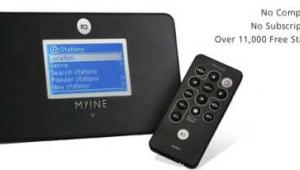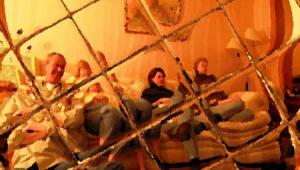HD Radio and the Boston Acoustics

A few of the radio stations around here in Connecticut are advertising their "High Definition" transmission capability. Terms like "CD quality" are bandied about and the implication is clear. HD Radio is terrestrial radio's answer to Sirius and XM. Except, ugh, it's not. For starters, XM on Directv doesn't sound all that special, just acceptable, so that's not necessarily a goal worthy of a shot. What XM and Sirius do offer is an easy way to navigate myriad channels in search of something to suite your frame of mind. The FM band has only about 25 available stations in any given market, since the FCC rightly frowns on stations in geographic proximity broadcasting on adjacent channel. With multi-casting of additional programming on an HD station's multiple digital subcarriers, HD Radio could easily double the number of free listening choices.
According to the industry promotion web site, HDRadio.com, you can "get the kind of sound that was previously reserved for your HDTV, CD system or MP3 player.". Excuse me, but I have actually three kinds of sound reserved for those, with CD's 1.4 megabit stereo bit rate at the top of that list and MP3's variable and most times objectionable low-resolution rate way down at the bottom. The HDRadio web site actually has "samples" of what HD radio sounds like. Of course, the samples are being sent over the internet in a compressed format (to the web site's credit, they do note this) so it's about as useful and illuminating as the post WWII habit of watching an ad for a color TV on a black and white one.
Boston Acoustics was kind enough to send me their Receptor Radio HD to let me evaluate HD's potential. My first thought was that I might be able to get better reception in my office than I could with an old JVC table top radio that I recently restored. The steel framed walls in our two story office are highly effective at blocking just about all AM reception and the FM stations that do come in are noisy.
Unfortunately, this $300 radio from Boston Acoustics was only able to bring in one non-HD radio station and no HD radio stations at all in my office. I tried moving the radio around the room, even placing the provided dipole antenna in positions where it would never be allowed to remain, but alas, the 24 year old JVC quite thoroughly kicked its butt. (Not a surprise, but a subject for another blog – the JVC has the best FM tuner I've ever encountered).
So I brought the Receptor Radio HD home and tried it outside during a party where we needed some tunes. It was some 20 feet away from where the guests were seated, and this time, it sounded great! Best of all, the remote control worked from over 30 feet away, which is a nice bonus. As for the differences between HD and non-HD stations, those weren't readily apparent that day, but the system had plenty of volume and good bass extension even with the world as its backdrop.
After the party, the radio moved indoors to the kitchen. People regularly use it and generally give it high marks for its sound but low marks for its reception. The long white dipole antenna is seen variously tied off on the cabinet door knobs for best reception, or bundled into a ball when guests arrive. In the latter "fetal" position, it may as well be unplugged for all the aid it provides to reception. I suspect the inclusion of two separate alarms means the radio was envisioned for use in a bedroom, but it would work well in any room, especially a kitchen or office (well, I guess not my office). There's also an auxiliary input so you can plug in your 'Pod or CD player when you're sick of listening to commercials.
The radio doesn't allow you to select between a given station's HD and non-HD signals. If HD is detected, that's what you get. That makes comparisons impossible. I wonder if that's intentional? Can I say with all honesty that an HD station playing 'X' sounded better than a non-HD station playing 'Y' ? No, I could not. The radio did make both sound pretty good however. Since digital radio is, like digital TV, an all or nothing proposition, you'll never hear a weak or noisy HD station. Either you get it, or you don't. If you don't get it, meaning the signal is too weak to provide a decipherable digital signal, the radio shoots you over to the standard analog station replete with all the hiss and multi-path interference you've come to know and love.
A few of the HD stations in Connecticut multi-cast and here's the real charm of the BA radio. Some of the extra digital channels just play music, remind you of their call letters once in a while, but remain totally commercial free. Better yet, the songs on the commercially free channels are better cuts than the tired old ones on the band with the advertising. I'm sure it won't last, but I'm enjoying it until radio stations figure out how to turn these multi-cast stations into cash cows as well. After all, somebody has to pay the bills.
While the radio had great bass when used outside, the two bass ports produce too much bass once inside. Boston Acoustics doesn't provide any bass or treble controls to help compensate, though ideally, a notch filter for "indoors / outdoors" on the back might be the best solution. Another criticism of the radio would be that it doesn't pull as many stations as I'd expect and that, in the kitchen at least, I found that HD stations would cut in and out as I walked away from the radio. I could always find a better position for the antenna to make this stop, but it was a pain. If you're a remote equipped channel surfer, this radio is NOT for you.
Gripes aside, the Boston Acoustics Receptor Radio HD really is a great sounding and great looking radio that would probably work better in a metropolitan area where radio signals are stronger than in the northwest hills of Connecticut. If you're looking for a solidly built, classy looking radio, you need to check out the Boston Acoustics Receptor Radio HD.
- Log in or register to post comments


























































